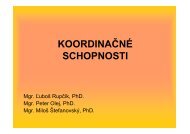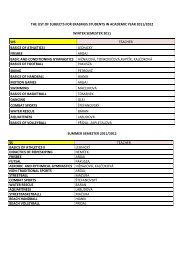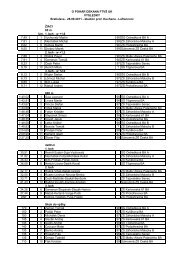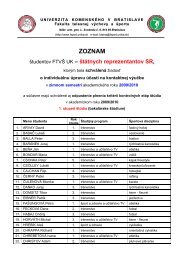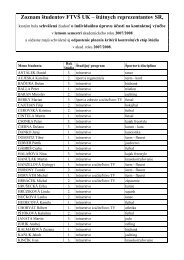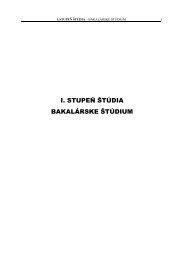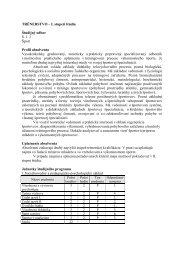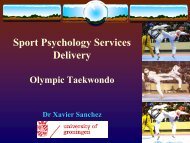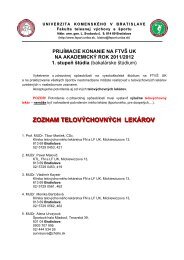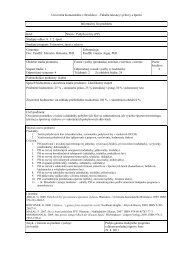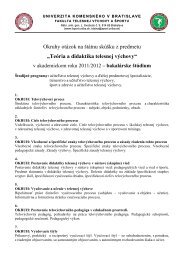acta facultatis educationis physicae universitatis comenianae
acta facultatis educationis physicae universitatis comenianae
acta facultatis educationis physicae universitatis comenianae
You also want an ePaper? Increase the reach of your titles
YUMPU automatically turns print PDFs into web optimized ePapers that Google loves.
Analyze of sport talent selection systems<br />
17<br />
Table 3<br />
Recommended features of the Stage of Initial Training Stage<br />
Duration<br />
(years)<br />
1 – 2<br />
Age ranges<br />
(years)<br />
6 – 8<br />
9 – 11<br />
12 – 14<br />
Sessions per year Hours a week Session Duration<br />
120 – 130 3.5 – 6 1 – 1.5 hrs<br />
development, arranged and delivered to them through physical education classes at school.<br />
Children, who for whatever reason were not selected to practice any sports, keep getting<br />
their share of multilateral development in school physical education classes and wait for<br />
another chance to be identified as talent for other sports in another age group.<br />
And although Talent Development traditionally relates to development of a talent through<br />
sports, we introduce here for the first time the concept of Pre-Detection Talent Development.<br />
In which Talent Development begins way before the talent is in fact identified by coaches<br />
or sports scientists. Naturally, after talent is detected and placed in the chosen sports environment,<br />
begins what we suggest to term as Post-Detection Talent Development which has<br />
to result in the improvement of performance in the chosen sport.<br />
Advanced stages of Talent Identification<br />
Intermediate Talent Identification<br />
Next stage of Talent Identification, (which we suggest to term as Talent Confirmation)<br />
happens further down during the Stage of Basic Training. In different principle models<br />
available in TID practices, next stages are progressively more specialized in relation to the<br />
chosen sports. Intermediate Talent Identification, as usually called in East European models<br />
of TID and development is in fact talent confirmation and placement. Main question to answer<br />
is: whether potential of a child is sufficient to reach Junior National level. It means if he/she<br />
has no limiting factors in health, motor qualities, skills, psychological sphere etc.(Havlíček,<br />
1982; Harsányi, Martin, 1983; Sedláček et al 1994; Platonov, 2002; Moravec et al, 2004;<br />
Krasilshchikov et al, 2010;). In Western Models it sounds as directing athletes to the sports<br />
in which they are likely to succeed and pointing out inherent limitations in their capacity<br />
(Peltola, 1992; Williams, Reilly, 2000; Krasilshchikov et al, 2010; Woodman, 1985). Tests<br />
and measurements have to reflect both general and specific fitness. Similar to the initial<br />
talent identification battery of tests (for general fitness) could be retained with induction<br />
of some additional specific tests reflecting level of skills, gained during acquired training.<br />
Ratio of general and specific tests must be around 50 : 50. Basic tests along with progress<br />
assessment will give clear picture of improvement in motor qualities. Specific test results<br />
should be taken into consideration while clarifying the discipline and event for further training.<br />
Physiological tests are of great importance because of forthcoming period of increased loads<br />
& tougher training. Physiological tests - what event a person is inclined to functional systemswise<br />
(sprints / speed – strength / long distance events / endurance etc.). Rephrasing a bit – inter-<br />
Acta Facultatis Educationis Physicae Universitatis Comenianae LII/I



